Population 1.749 billion (2013) Demonym Subcontinental | Population density 387/km | |
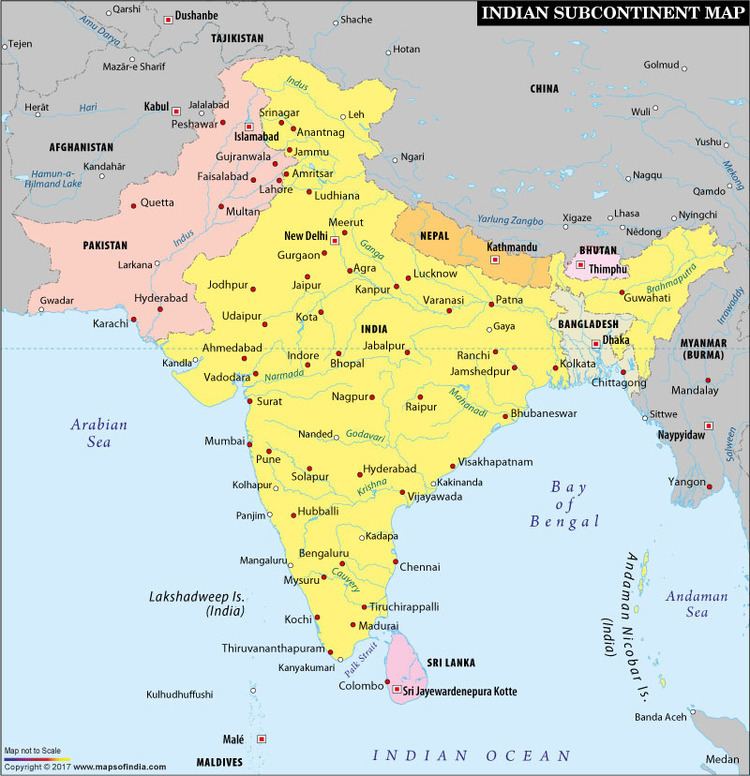 | ||
Area 4.4 million km (1.7 million mi²) Countries BangladeshBhutanIndiaMaldivesPakistanNepalSri Lanka Similar India, Southeast Asia, Central Asia | ||
The Indian subcontinent or the subcontinent, also called Indian continent, is a southern region of Asia, mostly situated on the Indian Plate and projecting southwards into the Indian Ocean from the Himalayas. Geologically, the Indian subcontinent is related to the land mass that rifted from Gondwana and merged with the Eurasian plate nearly 55 million years ago. Geographically, it is the peninsular region in south-central Asia delineated by the Himalayas in the north, the Hindu Kush in the west, and the Arakanese in the east. Politically, the Indian subcontinent usually includes Bangladesh, Bhutan, India, Maldives, Nepal, Pakistan and Sri Lanka.
Contents
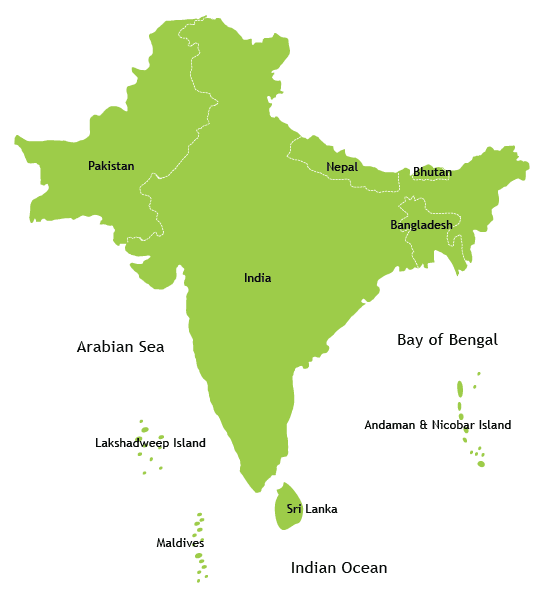
Sometimes, the term South Asia is used interchangeably with Indian subcontinent. There is no consensus about which countries should be included in each.
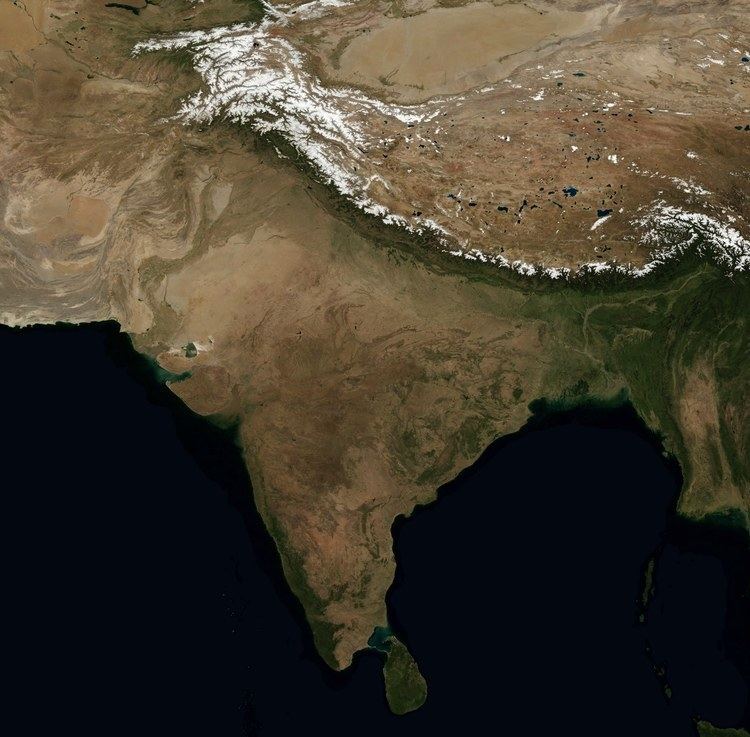
Etymology
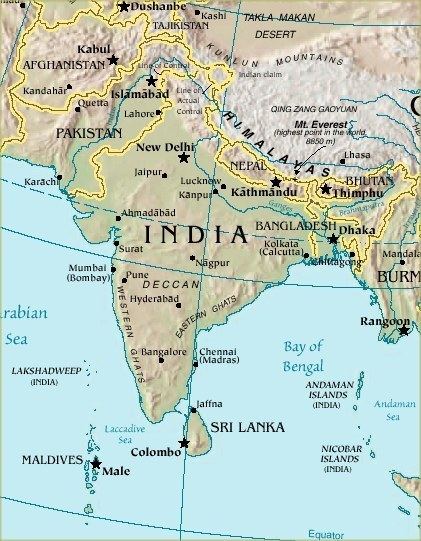
According to the Oxford English Dictionary, the term "subcontinent" signifies a "subdivision of a continent which has a distinct geographical, political, or cultural identity" and also a "large land mass somewhat smaller than a continent". It is first attested in 1845 to refer to the North and South Americas, before they were regarded as separate continents. Its use to refer to the Indian subcontinent is seen from the early twentieth century. It was especially convenient for referring to the region comprising both the British India and the princely states under British Paramountcy.
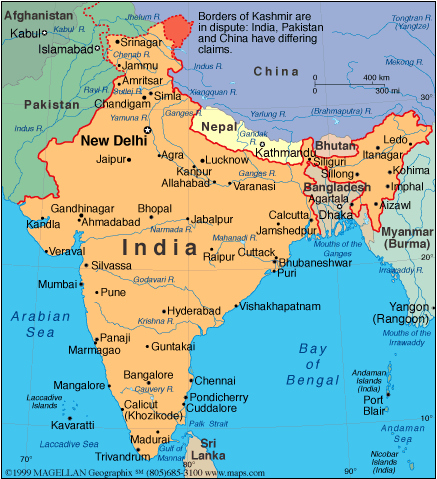
The term Indian subcontinent also has a geological significance. It was, like the various continents, a part of the supercontinent of Gondwana. A series of tectonic splits caused formation of various basins, each drifting in various directions. The geological region called the "Greater India" once included the Madagascar, Seychelles, Antartica, Austrolasia along with the Indian subcontinent basin. As a geological term, Indian subcontinent has meant that region formed from the collision of the Indian basin with Eurasia nearly 55 million years ago, towards the end of Paleocene.
Nomenclature
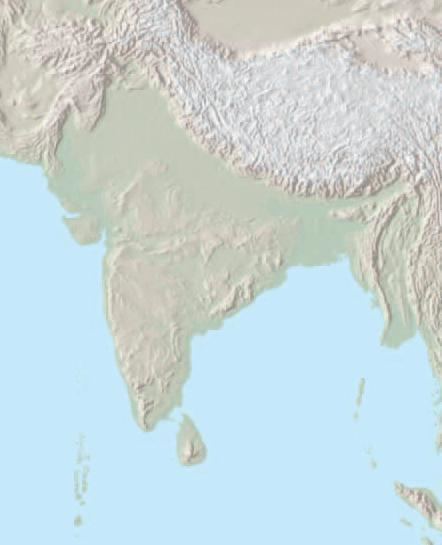
The Indian subcontinent has been a term particularly common in the British Empire and its successors. The region, state Mittal and Thursby, has also been labelled as India (in its classical and pre-modern sense), Greater India, or as South Asia. The BBC and some academic sources refer to the region as the "Asian Subcontinent". Some academics refer to it as "South Asian Subcontinent".
The terms "Indian subcontinent" and "South Asia" are sometimes used interchangeably. There is no globally accepted definition on which countries are a part of South Asia or Indian subcontinent.
Definition
In dictionary entries, the term subcontinent signifies a large, distinguishable subdivision of a continent.
Geology
Geologically, the Indian subcontinent was first a part of so-called "Greater India", a region of Gondwana that drifted away from East Africa about 160 million years ago, around the Middle Jurasic period. The region experienced high volcanic activity and plate subdivisions, creating Madagascar, Seychelles, Antartica, Austrolasia and the Indian subcontinent basin. The Indian subcontinent drifted northeastwards, colliding with the Eurasian plate nearly 55 million years ago, towards the end of Paleocene. This geological region largely includes Bangladesh, Bhutan, India, Maldives, Nepal, Pakistan and Sri Lanka. The zone where the Eurasian and Indian subcontinent plates meet remains one of the geologically active areas, prone to major earthquakes.
The English term mainly continues to refer to the Indian subcontinent. Physiographically, it is a peninsular region in south-central Asia delineated by the Himalayas in the north, the Hindu Kush in the west, and the Arakanese in the east. It extends southward into the Indian Ocean with the Arabian Sea to the southwest and the Bay of Bengal to the southeast. Most of this region rests on the Indian Plate and is isolated from the rest of Asia by large mountain barriers.
Politics
Whether called the Indian subcontinent or South Asia, the definition of the geographical extent of this region varies. Geopolitically, it had formed the whole territory of Greater India, and it generally comprises the countries of India, Pakistan, and Bangladesh. Prior to 1947, most of the Indian subcontinent was part of British India. It generally includes Nepal, Bhutan, and the island country of Sri Lanka and may also include the island country of Maldives. According to anthropologist John R. Lukacs, "the Indian Subcontinent occupies the major landmass of South Asia", while the political science professor Tatu Vanhanen states, "the seven countries of South Asia constitute geographically a compact region around the Indian Subcontinent". The geopolitical boundaries of Indian subcontinent, according to Dhavendra Kumar, include "India, Pakistan, Bangladesh, Sri Lanka, Nepal, Bhutan and other small islands of the Indian Ocean". Maldives, the small archipelago southwest of the peninsula, is considered part of the Indian subcontinent.
Parts of Afghanistan are sometimes included in Indian subcontinent as, states Ira M. Lapidus – a professor of History, it is a boundary territory with parts in Central Asia and in Indian subcontinent. The socio-religious history of Afghanistan are related to the Turkish-influenced Central Asia and northwestern parts of the Indian subcontinent, now known as Pakistan. Others state Afghanistan being a part of Central Asia is not an accepted practice, and it is "clearly not part of the Indian subcontinent".
Historians Catherine Asher and Cynthia Talbot state that the term "Indian subcontinent" describes a natural physical landmass in South Asia that has been relatively isolated from the rest of Eurasia. Given the passage difficulty through the Himalayas, the sociocultural, religious and political interaction of Indian subcontinent has largely been through the valleys of Afghanistan in its northwest, the valleys of Manipur in its east, and by maritime over sea. More difficult but historically important interaction has also occurred through passages pioneered by the Tibetans. These routes and interactions have led to the diffusion of Hinduism and Buddhism, for example, out of the Indian subcontinent into other parts of Asia, while Islam arrived into the Indian subcontinent through Afghanistan and to its coasts through the maritime routes.
Disagreements
The geopolitical definition and the use of terms such as Indian subcontinent, South Asian subcontinent and South Asia is a contested topic.
